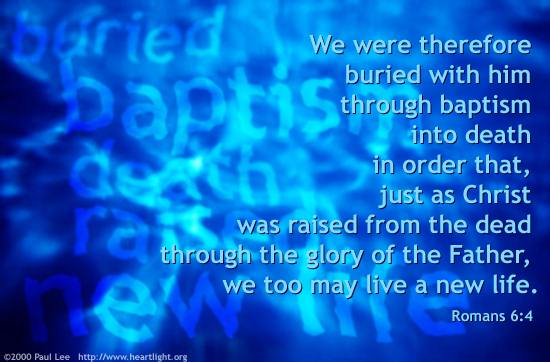Romans 6 may be the most famous passage in the Bible about baptism.
It is this chapter which is most often preached at baptismal services, and these are the Scriptures people go to when they want to talk about the symbolism, necessity, and power of baptism. During baptismal classes, it is this passage that pastors use to explain the meaning and significance of baptism. And this is with good reason, since the chapter does contain some great truths about baptism.

Romans 6 is about Spirit Baptism
The problem is that Romans 6 is not exactly about water baptism. It is primarily about Spirit baptism. We know this because water baptism does not result in dying with Christ (6:4), and the parallel passage in Colossians 2:11-12 compares spiritual circumcision with spiritual baptism.
Furthermore, the flow of argument in Paul’s letter to the Romans shows that he has Spirit baptism in mind. in Romans 4–5, Paul has gone into great detail about how a person is justified before God. Justification, he says, is by faith alone, apart from works of any kind (cf. Rom 4:4-5; 5:1, 21).
Now, in Romans 6, Paul begins to talk about what our justification means in real life. He continues this discussion all the way through chapter 8. The overall context of Romans 6–8 emphasizes the spiritual benefits of being identified with Christ. Paul’s ultimate point in these chapters is that we have been completely freed from sin and the law through the Spirit. When we believe in Jesus for eternal life, the Holy Spirit places us into Jesus so that we live with Him, die with Him, and are raised to new life with Him. Being washed with water is not what accomplishes this, but rather, it is being fully identified with the life, death, and resurrection of Jesus through the work of the Spirit that gives us this freedom from sin and the law.

This point become much more clear in Romans 6 if we remember that “baptism” means “immersion into” or “fully identified with.” With this in mind, Romans 6:2-4 reads this way:
How shall we who died to sin live any longer in it? Or do you not know that as many of us as were fully identified with Jesus Christ were fully identified with His death? Therefore we were buried with Him through being fully identified with death, that just as Christ was raised from the dead by the glory of the Father, even so we should walk in newness of life.
What about Water Baptism?
It seems clear from such a reading that Paul is talking primarily about what the Spirit does for those who believe. Paul would probably hasten to add that although it the Holy Spirit who accomplishes this complete identification with Jesus, it is helpful to provide an outward symbol of this inner reality by undergoing water baptism. This would then enable those who believed with a natural opportunity to explain to friends and family what had happened to them.
Review of Scriptures on Baptism
What we have seen throughout this survey of Scriptures on baptism is that water baptism was a symbolic ritual in biblical times which everybody understood, even those who were not followers of Jesus. It was practiced in nearly every culture and every religion of the Middle East to symbolize death to the past and full identification with a new way of living for the future. Because the symbolism was so widely recognized, when someone received baptism, their friends, family, and coworkers would ask them what they were dying to, what their future life would look like, and why they were making this drastic change.
So the question for us today is this: Is water baptism still required today? Does it share the same universal symbolism that it did in the days of Jesus and the apostles? If not, is there some other symbolic ritual that might accomplish the same purpose as baptism, but which is more universally recognized?
It is these questions we begin to address tomorrow.




Well said Jeremy, there is a profound difference between getting wet, and being born from above.
Yes, yes! Yet so few seem to grasp the difference!